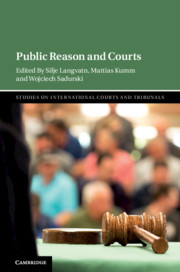Book contents
- Public Reason and Courts
- Studies on International Courts and Tribunals
- Public Reason and Courts
- Copyright page
- Contents
- Contributors
- Preface
- Acknowledgments
- 1 Taking Public Reason to Court: Understanding References to Public Reason in Discussions about Courts and Adjudication
- Part I Public Reason in Constitutional Courts
- Part II Public Reason in International Courts and Tribunals
- 9 European Court of Human Rights in Pursuit of Public Reason? A Study of Lost Opportunities
- 10 The Right to Justification in the Context of Proportionality: A Plea for Determinacy and Stability
- 11 “Going Public”: Reasoning and Justification at the World Trade Court
- Part III Critical Perspective on Public Reason in Courts
- Index
9 - European Court of Human Rights in Pursuit of Public Reason? A Study of Lost Opportunities
from Part II - Public Reason in International Courts and Tribunals
Published online by Cambridge University Press: 22 May 2020
- Public Reason and Courts
- Studies on International Courts and Tribunals
- Public Reason and Courts
- Copyright page
- Contents
- Contributors
- Preface
- Acknowledgments
- 1 Taking Public Reason to Court: Understanding References to Public Reason in Discussions about Courts and Adjudication
- Part I Public Reason in Constitutional Courts
- Part II Public Reason in International Courts and Tribunals
- 9 European Court of Human Rights in Pursuit of Public Reason? A Study of Lost Opportunities
- 10 The Right to Justification in the Context of Proportionality: A Plea for Determinacy and Stability
- 11 “Going Public”: Reasoning and Justification at the World Trade Court
- Part III Critical Perspective on Public Reason in Courts
- Index
Summary
Wojciech Sadurski considers how the European Court of Human Rights (ECtHR), an emerging European constitutional court for human rights, has engaged in a public reason compatible scrutiny of legislative aims pursued by national laws interfering with the proclaimed rights. Sadurski concludes that the Court has almost always eschewed its authority to evaluate the aims of state laws or decisions in this way. On the very few occasions when it did express its doubts about the plausibility of the aims cited by the governments concerned, the Court either refused to attach any weight to these doubts and moved on to the next stage in the analysis (the necessity scrutiny). The main burden of the aim scrutiny was therefore shifted to the necessity stage, when the Court assessed whether the restrictions were necessary (in a democratic society) to attain this aim. Sadurski offers an explanation for this puzzling (as he claims) argumentative maneuver. Challenging the state at stage of aim ascertainment brings the Court into a head-on collision course with the state and risks weakening the Court’s legitimacy, which is tenuous at the best of times anyway.
Keywords
- Type
- Chapter
- Information
- Public Reason and Courts , pp. 231 - 255Publisher: Cambridge University PressPrint publication year: 2020

